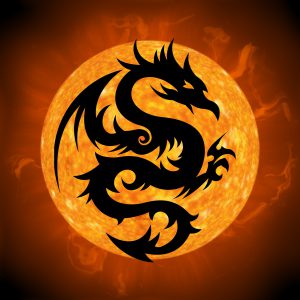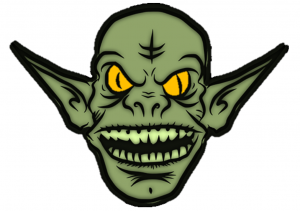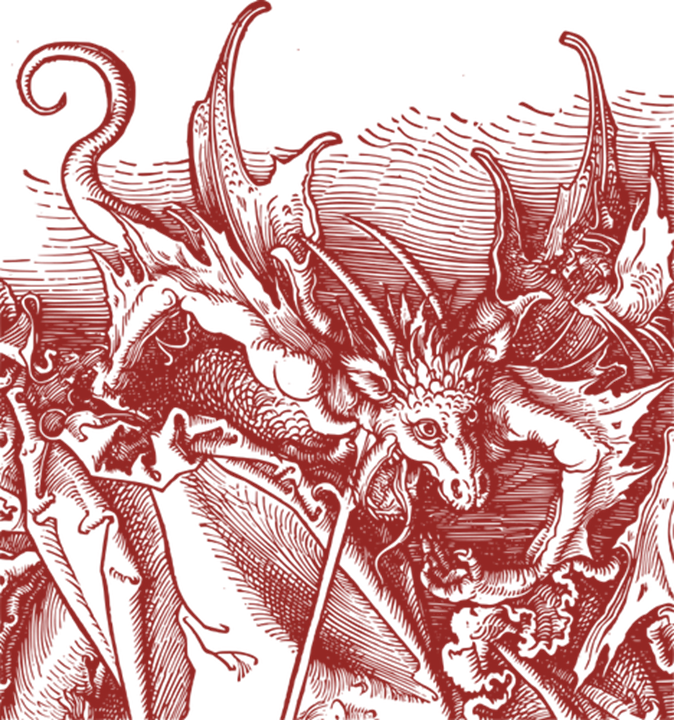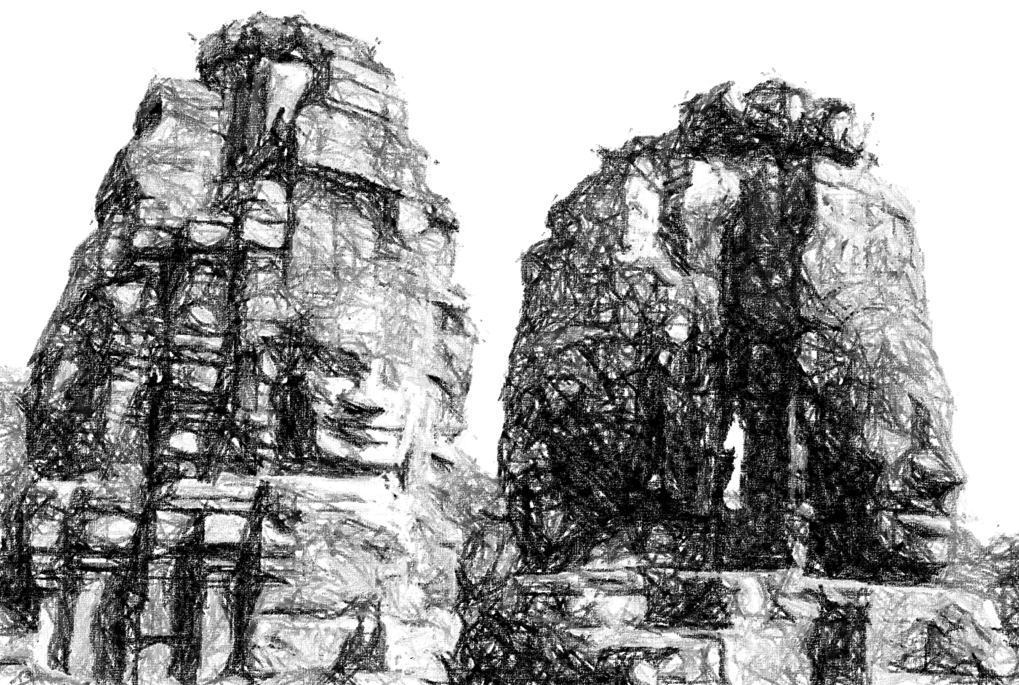Dear reader, thank you for coming back! This is part 2 (although technically it is the third post) of the Garesia campaign. This all began as an adventure that became the idea for a campaign. When I wrote the first post I thought I’d be done with this topic in one or two entries, but here we are and the ideas just keep coming.
After the last post I started writing about the peoples and races of Garesia, but I kept referencing a creation myth that I had in mind. As more and more ideas and details for the creation myth came to me, I set aside the races and people details for another post, and ended up writing this one. The topics for today are creation myths and the gods of the world of Garesia. Let me know what you think in the comments.
Creation Myth of Garesia
The people of Garesia share a common creation myth, and while the relentless passage of time has indubitably led to different peoples embellishing these tales to reinforce their particular place in these legends, the longer lived races still preserve the tales as told to them by their deities.
At the beginning of the Immortal Age the gods gathered and with their power brought together the raw material of creation into a great maelstrom. From the void they called the dragons and made them their first servants, setting them upon the task of taming the great storm. The dragons separated the heavens from the earth, the land from the sea, and from the coalescing indomitable conflict of chaos versus order, gave forth Garesia to their masters.
But the maelstrom had leaked outside this reality into the beyond, and the act of creation had in turn given form to other worlds, other realities. In their need to classify and name what they don’t truly understand mortals have called these other worlds beyond by many names, most commonly the Planes, and classified the varying worlds into the Inner and Outer Planes and other distinctions that seem to limit the limitless. But at the time of creation these worlds beyond were merely the reflection of the light and the shadow, the fire and the wind, that formed Garesia. When their work was done, the gods sent the dragons to tend to the complex weave of creation the worlds beyond had become. Thus the way name mortal use to classify, understand and represent the relation and movement of these other worlds they call the Planes is known as the Dragons’ Path.
Upon Garesia, the gods created the First People. Each made in their creator’s image, embodiments of their values and ideals. The gods taught them their way, protecting them, and taking care of their every need. Their followers in turn worshipped and served their gods. The elves, orcs, dwarves, gnomes, halflings, and goblins were among the First People. Humans were among them, but they had no deity guiding them, and they lived far harsher lives than any of the First People. Their origins a mystery, for no deity claimed dominion over them. Some speculate they were the spawn of the clashing forces contained by the creation of Garesia given form.
In lieu of guidance from a deity, the druid circles were the first form of worship among the humans. They deciphered and imparted to other humans the way of the First Faith, the secret rituals of nature, the worship of the essence and power of Garesia itself, and through these druids, the rest of the First People learned of the gifts of Mother Garesia. Only then, and thanks to the druids, did the rest of the First People come to trust the humans.
Each of the First People thrived and the gods themselves multiplied, new deities were born of the union of mortal and immortal. From this new generation of demi-gods came the betrayal that would end the gods’ time upon Garesia. The plot to kill the young children of the goblin deity sparked the war that would end the Immortal Age and bring about the Immortals’ War!
One of the younger offspring of the elven deity plotted with the ambitious offspring of the goddess of the orcs. Their machinations intended to bring about conflict between the first generation of gods, thus allowing the upstarts to usurp the power of their progenitors while they were embroiled in war. But their intrigues backfired. The orc assassins sent to kill the goblin demi-gods killed not only them, but the goblin god himself! This act of deicide shattered the goblin god’s divine vessel, his nature devoid of form and function came to reside in each of his followers, the goblinoids driven mad by the howls of their god’s conscience to pieces!
The goblin horde arose in a furious wrath, and blaming the orcs for the death of their god, descended upon the orc lands with hitherto unknown fury. The orc goddess was killed and her son, one of the two conspirators responsible for unleashing this madness, consumed by rage, killed his elven accomplice and plucked one of his eyes out in penance. Taking command of his mother’s people he became known as the One Eyed Scourge and turned the orcs down a path of savagery, war and destruction. Deity fought deity, their followers died and were raised to continue fighting, and the chaos they unleashed not only changed the nature of their followers, but gave birth to the second people, the other races that still populate the more dangerous corners of the world. But the Immortals’ War continued unrelentingly and as a result more deities of the first generation died, their divine vessel destroyed, their essence consumed in the ravages or a war unlike any other even seen in Garesia.
Shaken by the realization that their immortal nature could be destroyed, the gods accepted the inevitable. If they wished to continue their endless existence, they could no longer remain in this world. They each created a sanctuary in the beyond, in the Outer Planes, a realm closely tied to their nature, a place where their immortal nature would be safe and intact. Their followers would now live out their finite lives in the world they had created, and upon their death, their soul would travel to the bosom of their deity to live in his or her glory. Thus began inevitable chain of events that would lead to the end Immortal Age and the coming of the Time of Mortals.
But the war was far from over… one of the immortals had remained behind, the One Eyed Scourge. His servants the orcs warred against their enemies the elves. The mightiest and most cunning generals of the elvish people, the Twelve Swords, gathered their armies and not only killed the orc god, but scattered the great orc armies. The broken orcs ravaged across Garesia and the other races suffered the consequences, especially the humans. In their hour of greatest need, and with the druids unable to stop the onslaught of the orcs, humans turned to the darkest offspring of the Immortals’ War for help, the Fiends of the Night.
Forged from the madness, bloodletting and anger of the Immortals’ War given form, these creatures, touched by the darkness and chaos that seeped from Garesia during the war between the gods, hid in the darkest and foulest worlds beyond, the Lower Planes. They travelled thought the Land of Shadows and into the night of the Garesia. From the shadows they tempted the desperate humans with protection from the orcs in exchange for their servitude.
Many desperate human tribes became their followers and by the power of the Fiends of Night new race of beings was spawned from this profane union, the tieflings. These corrupted creatures in turn commanded their progenitor’s servants and brought more and more humans to their dark ways. This unholy alliance kept the orcs at bay, for a time, but the price humans paid was too high. From among the humans tribes untouched by the taint of the tieflings, came the prophets of the Great Faith. They liberated the humans from the influence of the Fiends of the Night, locked the gates that gave them passage from the Lower Planes through the Land of Shadows, and hunted their mortal offspring; teaching the humans the secret of metallurgy and arcane magic.
Thus was all trace of true immortal power gone from Garesia. The Great Faith preached the ideals of order, justice and honor, paths to righteousness and salvation embodied by now absent, distant and eerily silent gods. Thus the raise of the Great Faith marked the true beginning of the Time of Mortals upon the world.
The Deities of Garesia
As you can see in the creation myth above I kept the names of specific god undefined, instead each is simply referred to by the people they created and shepherded in the early times of Garesia. The reason is twofold, first the people of Garesia know the power of true names, and thus the secret names of the gods are only whispered by their priests in secret rituals. Servants of the evil demons and devils of the lower planes refer to them by their titles or monikers earned by their horrible deeds. The other reason that many in Garesia don’t refer to their gods by their names is that many have been forgotten.
Demi-gods or other minor powers may still be called by their name, typically not their true name, but the true gods of each of the First People are known simply as the God of the Elves, or the God of the Halflings. Indeed of the First People, only the elves and halflings continue the traditions of old and worship these ancient deities.
When the god of the dwarves left the mortal world, the dwarven bloodlines considered this the ultimate betrayal. They destroyed the god’s temples and began a long tradition of ancestor worship. The gnome deity was a casualty of the Immortals’ War and the subsequent destruction of their great city and the Great Machine they had fashioned into their gods, means that gnomes follow no deity. Clerics among them have taken the vows of other religions, typically druids, or the ways of the Great Faith, but they are a dying people, less than a thousand left in all Garesia.
The goblin deity is a mad voice haunting every goblin, hobgoblin and bugbear alive. They share a hive-mind like consciousness, and each type of goblin has changed through the ages to fulfill a role in the great madness of the goblin horde. The orc goddess, and her son the One Eyed Scourge, both died in ancient times, and the orcs in Garesia engage in bloody sacrifices and rituals to their memory. These rituals have been corrupted by the powers of the Night Fiends, who grant orc shamans their power. Some orcs worship the Five Lords of Dragonkind and through them grown in power.
The Second People each worship some deity, oftentimes demi-gods left without followers, or cast away from the realms of their progenitors. They have become like the races that worship them and seek to build their power in the Outer Planes.
The mightiest of dragons that did not heed the call to return to the mortal world, have become as unto gods themselves. The Dragon Queen rules alone over the order and light of the Dragon’s Path that traverses the Planes beyond the mortal world. She once ruled along her four sisters, but their five betrothed betrayed them, killing all but the one who became the Dragon Queen. The Five Lords of Dragonkind rule over the treacherous ways, the chaos, and the darkness of the dragon Way.
The few dragonborn and tiefling left in Garesia typically worship their creators; the Dragon Queen or the Five Lords in the case of dragonborn, depending on their nature. For tieflings, those that embrace their dark origins often become leaders of cults to the Fiends of Night. Those that seek redemption sometimes try to follow the tenets of the First Faith or even the Great Faith, not an easy task when they are so universally hated and mistrusted.
Most humans follow the Great Faith, a vast, monolithic, bureaucratic institution that has shaped human history during the Mortal Age. They emphasize order and obedience, strict adherence to the teaching of the founding prophets is the path to salvation. While they speak of the gods of old and some traditions are based upon theses poorly defined and malleable godly figures, the nine prophets and the patriarch’s interpretation of their word is far more important. Following the Coming of the Giants doctrinal differences among the members of the Great Faith became marked and cause much strain within the organization. The time of the Dragon Dynasties exacerbated there and following their destruction the Great Faith suffered a great schism!
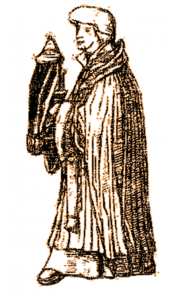 The Great Faith broke in two; the orthodoxy of the Great Faith is composed on the more autocratic elements while the reform Great Faith has reformulated the beliefs and dogma of their religion and seeks to cut ties with the past. The orthodox branch refuses to recognize the reformer and still attempts to rule over them. The reformers are fractured among themselves and often fight amongst themselves as bitterly as they do with those who follow the older traditions.
The Great Faith broke in two; the orthodoxy of the Great Faith is composed on the more autocratic elements while the reform Great Faith has reformulated the beliefs and dogma of their religion and seeks to cut ties with the past. The orthodox branch refuses to recognize the reformer and still attempts to rule over them. The reformers are fractured among themselves and often fight amongst themselves as bitterly as they do with those who follow the older traditions.
This fracturing and infighting has weakened the power of the faith and allowed the rise to prominence of nobles and merchants as influential powers within human society. Even the First Faith, long at odds with the Great Faith and relegated to the wild and rural areas in human lands, has made inroads in human towns and cities.
*******
I think I’ll close this entry on creation myths and gods for now. It covers pretty much the ground I needed to as to make sense of the next entry I’m working on, The People and Races of Garesia. That still needs some work, and this post itself was rather long and wordy. I may need to do another read-over (of which I’ve done a few by now) once I’ve steeped back and worked on something else.
Thanks for your patience, and forgive any mistakes in inconsistencies above. Thanks for your interest in this, and if you have any suggestions, or catch any gross errors or inconsistencies, feel free to leave me a message in the comments. Again, thank you. See you soon!



